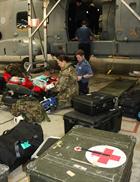Merlin expands its medical role
Royal Naval Medical Service (RNMS) personnel have been impressed by the Merlin Helicopter as they look to build on the aircraft’s success during recent operations.
Visiting Royal Naval Air Station Culdrose a team of Medical experts from RNMS used their skills and knowledge gathered on operations, to assess how the Navy’s grey Merlin Fleet can be used to move casualties in the Maritime In-Transit Care (MITC) role. Made up of medics, nurses and doctors, the team have experienced how a fast and efficient transit provided by Medical Emergency Response Teams (MERT) in Afghanistan has saved lives.
“Were looking at the potential medical capability of Merlin for contingency operations in support of the Lead Commando Group (LCG) and the Responsive Force Task Group (RFTG),” said Lieutenant Commander Karl Hurley, from NCHQ. “In Military Operations on land or at Sea we have to be able to move casualties safely and appropriately for any situation. We know that there are limited assets available and as well as Merlin we are also looking at Royal Marine Landing craft, Hovercraft and Armoured vehicles to move the wounded and injured.”
The Stretcher fit for this aircraft is just one of the options they have had time to study on their visit. Having a helicopter to try different configurations and layouts has been a good learning tool. They have also recognised a need to move seriously injured casualties and adapting the Merlin’s cabin space with a single Intensive Care Casualty frame has been useful. But what has really impressed them is how adaptable Merlin has proved. Within only a few hours Air Engineers can turn around the Anti-Submarine airframe into a large flying ambulance; capable of providing In-Transit care to forward areas and moving casualties between other medical facilities.
“The flexibility in the back of Merlin is quite surprising,” said Surgeon Commander Simon Leigh-Smith, one of the Royal Navy’s Emergency Medicine Consultants who works in the Royal Infirmary Edinburgh and is the Royal Navy Lead on advanced pre hospital care. “I’ve worked in the air on ‘Junglie’ Sea King MK 4’s and this offers the potential for greater use and a larger carriage of casualties and kit. It certainly gives an increased range for us to operate in forward areas and explore different Medical evacuation (MEDEVAC) roles.
The Royal Navy have been using Helicopters to move casualties around since the first ones appeared in the early 1950’s, whether a sick sailor from Ship to a shore-side hospital or battle casualties during the Falklands War or in Afghanistan, the concept is not new.
Lt Cdr Hurley continues, “We’re bringing together all our experiences over the years and how Civilian Air Ambulance’s work, to get the best out of our assets and provide a quicker and punchier service to those men and women that will be in harms way. Our work here will allow commanders to be briefed on what’s available and assist them in the planning stages of Land and Maritime operations in the future.”





